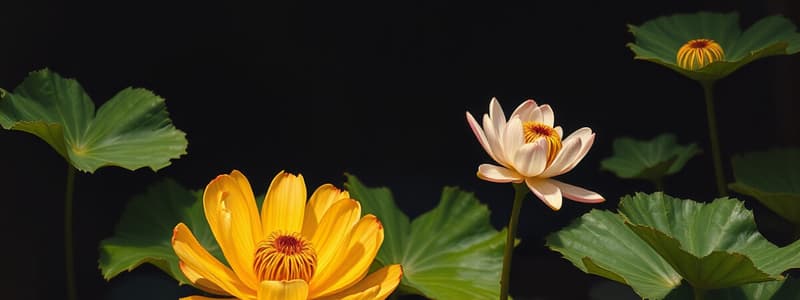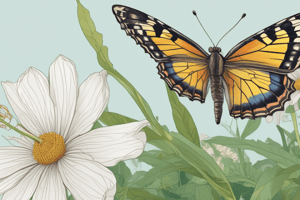Podcast
Questions and Answers
Self-pollination guarantees genetic variation in plants.
Self-pollination guarantees genetic variation in plants.
False (B)
The endosperm is formed when one male gamete fuses with the egg and the other fuses with polar nuclei.
The endosperm is formed when one male gamete fuses with the egg and the other fuses with polar nuclei.
True (A)
Wind-pollinated flowers are characterized by bright colors and sweet scents to attract pollinators.
Wind-pollinated flowers are characterized by bright colors and sweet scents to attract pollinators.
False (B)
Dormancy allows plants to begin germination during cold winter months.
Dormancy allows plants to begin germination during cold winter months.
Vegetative propagation involves gametes and fertilization.
Vegetative propagation involves gametes and fertilization.
The sporophyte stage of a plant is haploid and spends most of its life cycle as a diploid.
The sporophyte stage of a plant is haploid and spends most of its life cycle as a diploid.
Pollination is the process of transferring pollen from the stigma to the anther.
Pollination is the process of transferring pollen from the stigma to the anther.
Male and female gametes in flowering plants are produced during the gametophyte stage.
Male and female gametes in flowering plants are produced during the gametophyte stage.
The carpel is the male sexual organ of the flower.
The carpel is the male sexual organ of the flower.
The fusion of male and female gametes results in the formation of a diploid zygote.
The fusion of male and female gametes results in the formation of a diploid zygote.
Asexual reproduction requires two parents to produce offspring.
Asexual reproduction requires two parents to produce offspring.
Phototropism refers to a plant's growth in response to light.
Phototropism refers to a plant's growth in response to light.
Geotropism causes roots to grow against gravity.
Geotropism causes roots to grow against gravity.
Auxins are plant hormones that play a role in growth regulation.
Auxins are plant hormones that play a role in growth regulation.
Root tubers are unable to produce new plants during winter.
Root tubers are unable to produce new plants during winter.
Flashcards are hidden until you start studying
Study Notes
Plant Reproduction
- Flowering plants have a life cycle with two main stages: sporophyte (diploid) and gametophyte (haploid).
- Sporophytes produce spores through meiosis while gametophytes produce male and female gametes.
Flower Structure and Functions
- Sepal: Provides protection to the flower.
- Petal: Brightly colored to attract insect pollinators via color and fragrance.
- Stamen: Male reproductive organ producing male gametes.
- Filament: Thin stalk that supplies food and water to the anther.
- Anther: Sac-like structure that produces pollen through meiosis.
- Stigma: Receives pollen and is located at the top of the carpel.
- Ovary: Site of fertilization.
- Carpel: Female reproductive organ of the flower.
Fertilization Process
- Development begins from a zygote (fertilized egg), which forms into a sporophyte with roots and shoots.
- Male gametes fuse with female gametes to create a diploid zygote.
- Pollination occurs when pollen from an anther lands on the stigma of another flower.
- Sufficient pollination is essential for sexual reproduction, seed, and fruit formation as well as genetic variation.
Double Fertilization
- After pollination, the tube nucleus travels down the style to the micropyle in the ovary, dividing by mitosis to create two male gametes.
- One male gamete fuses with the egg, while the other fuses with polar nuclei to form endosperm for nourishment.
Pollination Methods
- Self-pollination: Pollen transfers from anther to stigma on the same plant; guarantees reproduction but reduces genetic variation.
- Cross-pollination: Pollen moves between different plants of the same species; promotes genetic diversity.
Adaptations of Pollination
- Wind-pollinated flowers: Long stamens, feathery stigmas, large amounts of light pollen, minimal color or scent.
- Insect-pollinated flowers: Bright petals and unique shapes attract pollinators; sticky pollen aids collection.
Seed Dispersal Methods
- Wind: Example - sycamore.
- Animal: Example - burdock seeds attach to fur.
- Self-dispersal: Example - pea plants explode their pods.
- Water: Example - seeds can float and disperse via water.
Dormancy and Vegetative Propagation
- Dormancy: Temporary growth pause to ensure survival during adverse conditions like winter.
- Vegetative propagation: Asexual reproduction without gametes; involves a single parent, rapid process, and produces identical offspring.
Root Tubers and Artificial Propagation
- Root tubers remain dormant and can grow new plants once conditions improve.
- Cuttings are portions removed from a parent plant and grown into new, independent plants.
Tropisms in Plants
- Tropism: Directional growth response to environmental stimuli, e.g., light or gravity.
- Phototropism: Stems grow toward light for optimal photosynthesis.
- Geotropism: Roots grow down towards gravity, and shoots grow up against gravity.
Auxins
- Auxins are plant hormones that regulate growth and response to stimuli.
Plant Families
- Various plants, such as buttercup, daisy, violet, pansy, nettle, and sunflower, are identified by their Latin names.
Studying That Suits You
Use AI to generate personalized quizzes and flashcards to suit your learning preferences.




